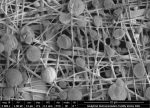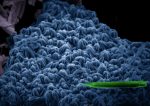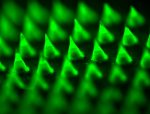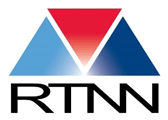
Congratulations to our image contest winner, Yaewon Park, for her entry, CaCO3 mineralized poly(vinyl alcohol) nanofibers.
This picture shows a Scanning Electron Microscopy (SEM) image of CaCO3 nanoparticle clusters encrusting electrospun poly(vinyl alcohol) nanofibers. This structure resembles bone structure which consists of collagen fibrils and hydroxyapatate crystals attached along them.
My current research is on surface coating of nanofibers with CaCO3 particles by mimicking bone formation process. My research is expected to give a light on environmentally friendly coating of functional textiles and water filtration materials. Nanofibers were dipped in CaCl2 solution and Na2CO3 solution alternatively for 10 times. This image shows that spherical CaCO3 particles surrounded the circumference of nanofibers. This interesting structure is similar to human bone structure.
Honorable Mention Images:
 Joshua Zhou: Coral Reef The viewing window of a scanning electron microscope halts before a field of “coral reef”, ordered clusters of vanadium oxide nanorods. Another rod rests on their surface, like a fish seeking shelter from predators. Characterizing the shape of vanadium oxide nanomaterials can account for changes in their thermochromic properties.
Joshua Zhou: Coral Reef The viewing window of a scanning electron microscope halts before a field of “coral reef”, ordered clusters of vanadium oxide nanorods. Another rod rests on their surface, like a fish seeking shelter from predators. Characterizing the shape of vanadium oxide nanomaterials can account for changes in their thermochromic properties.
This work aimed to form a titanium oxide-vanadium oxide composite doped with magnesium in order to increase the infrared blocking capability of thermochromic films. Efficient thermochromic films can be used in smart windows to block heat-bearing infrared radiation on hot days, while phase-shifting in cold weather to allow warmth in from sunlight. Phase shifts are temperature dependent and rely on no external supply of electricity. This can help reduce air-conditioning bills while maintaining room comfort.
 Yanqi Ye: Smart Melanoma Patch Fluorescence imaging of a representative microneedle patch that contained FITC-aPD1 loaded NPs for melanoma treatment. Despite recent advances in melanoma treatment through the use of anti-PD- 1 (aPD1) immunotherapy, the efficacy of this method remains to be improved. Here we report an innovative self-degradable microneedle (MN) patch for the sustained delivery of aPD1 in a physiologically controllable manner. Moreover, this administration strategy can integrate with other immunomodulators (such as anti-CTLA- 4) to achieve combination therapy for enhancing anti-tumor efficacy.
Yanqi Ye: Smart Melanoma Patch Fluorescence imaging of a representative microneedle patch that contained FITC-aPD1 loaded NPs for melanoma treatment. Despite recent advances in melanoma treatment through the use of anti-PD- 1 (aPD1) immunotherapy, the efficacy of this method remains to be improved. Here we report an innovative self-degradable microneedle (MN) patch for the sustained delivery of aPD1 in a physiologically controllable manner. Moreover, this administration strategy can integrate with other immunomodulators (such as anti-CTLA- 4) to achieve combination therapy for enhancing anti-tumor efficacy.
 We are excited to welcome Dr. Phil Barletta to the RTNN! Dr. Barletta will serve as Director of Operations for NC State’s Nanofabrication Facility (NNF). Dr. Barletta is a graduate of NC State (Ph.D. ‘06, M.S. ’99) who has spent the majority of the past decade at RTI International, where he was focused on the MOCVD growth of Bi2Te3-based thin-film materials and the processing, packaging, and testing of record-breaking Bi2Te3-based thin-film thermoelectric devices. During his career, Dr. Barletta has also studied bulk thermoelectrics, photovoltaics, long-wavelength IR detection, and solid-state lighting. His diverse research background includes publications regarding thermoelectrics, III-V material growth, and diamond-like carbon.
We are excited to welcome Dr. Phil Barletta to the RTNN! Dr. Barletta will serve as Director of Operations for NC State’s Nanofabrication Facility (NNF). Dr. Barletta is a graduate of NC State (Ph.D. ‘06, M.S. ’99) who has spent the majority of the past decade at RTI International, where he was focused on the MOCVD growth of Bi2Te3-based thin-film materials and the processing, packaging, and testing of record-breaking Bi2Te3-based thin-film thermoelectric devices. During his career, Dr. Barletta has also studied bulk thermoelectrics, photovoltaics, long-wavelength IR detection, and solid-state lighting. His diverse research background includes publications regarding thermoelectrics, III-V material growth, and diamond-like carbon.


 Joshua Zhou: Coral Reef The viewing window of a scanning electron microscope halts before a field of “coral reef”, ordered clusters of vanadium oxide nanorods. Another rod rests on their surface, like a fish seeking shelter from predators. Characterizing the shape of vanadium oxide nanomaterials can account for changes in their thermochromic properties.
Joshua Zhou: Coral Reef The viewing window of a scanning electron microscope halts before a field of “coral reef”, ordered clusters of vanadium oxide nanorods. Another rod rests on their surface, like a fish seeking shelter from predators. Characterizing the shape of vanadium oxide nanomaterials can account for changes in their thermochromic properties. Yanqi Ye: Smart Melanoma Patch Fluorescence imaging of a representative microneedle patch that contained FITC-aPD1 loaded NPs for melanoma treatment. Despite recent advances in melanoma treatment through the use of anti-PD- 1 (aPD1) immunotherapy, the efficacy of this method remains to be improved. Here we report an innovative self-degradable microneedle (MN) patch for the sustained delivery of aPD1 in a physiologically controllable manner. Moreover, this administration strategy can integrate with other immunomodulators (such as anti-CTLA- 4) to achieve combination therapy for enhancing anti-tumor efficacy.
Yanqi Ye: Smart Melanoma Patch Fluorescence imaging of a representative microneedle patch that contained FITC-aPD1 loaded NPs for melanoma treatment. Despite recent advances in melanoma treatment through the use of anti-PD- 1 (aPD1) immunotherapy, the efficacy of this method remains to be improved. Here we report an innovative self-degradable microneedle (MN) patch for the sustained delivery of aPD1 in a physiologically controllable manner. Moreover, this administration strategy can integrate with other immunomodulators (such as anti-CTLA- 4) to achieve combination therapy for enhancing anti-tumor efficacy.